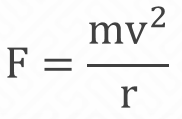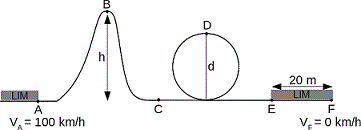P1019
A roller coaster is designed so that the car accelerates from rest due to a force applied by a Linear Induction Motor (LIM). The motor uses electromagnets in coordination with large currents in order to create a very strong force that propels the car and accelerates it from 0 to 100 km/h (~30 m/s) in 2.5 s. Figure 1 shows the blueprint of the ride.
After the car accelerates to the mentioned speed, Vi = 100 km/h (point A), it climbs a hill of height h (the top of the ride, point B), where it starts its descent to the initial level (point C), followed by a circular loop with a maximum height d (point D). In the loop, the car experiences a centrifugal force away from the center of the loop, counteracting the gravitational force downward. In this way, the car remains on the track rather than falling onto the ground. The centrifugal force is given by the equation:
where F is the centrifugal force, m is the mass of the car, v is the linear velocity of the car, and r is the radius of the loop.
Finally, the car enters the stopping zone (point E), where another induction system makes the car stop in 20 meters, reaching point F. Assume for this problem that the frictional forces are negligible, due to the construction materials used. The mass of the car plus passengers is 1000 kg. Assume acceleration due to gravity is 10 m/s2.
Figure 1. Depiction of roller coaster track.
Find an error? Take a screenshot, email it to us at error@mytestingsolution.com, and we’ll send you $3!


